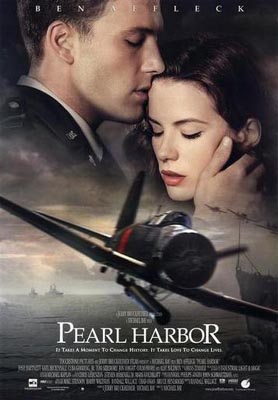This was posted up here on the 14 Feb 2001, shortly before the release of Michael Bay’s turkey of a mess Pearl Harbor movie.
 Another commonly made observation of the Pearl Harbor attack was that most pundits believe it was a complete success, with aircraft from the Japanese Imperial Navy sinking and devastating dozens of American battleships, cruisers and destroyers docked at the harbor. General Yamamoto had asserted that Japan’s only chance for victory against the United States was a devastating strike against its naval forces in the Pacific, and in so doing would shock the United States onto the bargaining table and sue for peace. Japan could then continue on to seize the resource rich lands of South-East Asia without American interference.
Another commonly made observation of the Pearl Harbor attack was that most pundits believe it was a complete success, with aircraft from the Japanese Imperial Navy sinking and devastating dozens of American battleships, cruisers and destroyers docked at the harbor. General Yamamoto had asserted that Japan’s only chance for victory against the United States was a devastating strike against its naval forces in the Pacific, and in so doing would shock the United States onto the bargaining table and sue for peace. Japan could then continue on to seize the resource rich lands of South-East Asia without American interference.
But in reality, the Pearl Harbor attack wasn’t an unqualified success, contrary to popular thinking. I would rather call it tactically a success with a large number of American battleships sunk while in dock, but strategically a big blunder on several counts. The American battleships were indeed sunk with great loss of lives (the battleship Arizona was hit directly in its ammunitions hold, exploded in the harbor, and sunk in minutes with two thousand of its crew sinking with her), but this only forced the American naval forces to place its aircraft carriers as the prime components in its strike forces; and her two aircraft carriers, the Lexington and the Yorktown, had mercifully escaped destruction. By a stroke of luck when the Japanese planes struck, they were out of harbor. And as it turned out, it was the American aircraft carriers which won the subsequent naval battles of the Pacific in the next 3 years.
In addition, Yamamoto missed out on a second opportunity that would have severely set back the American ability to react. Just beyond Pearl Harbor were a large field of fuel tanks that housed a good portion of the available fuel for the American naval forces. If these had been destroyed in the Pearl Harbor attack, fuel shortage would had posed a severe problem for the Americans. In fact, the astute Japanese pilots in the initial wave of attacking planes spotted the untouched fuel tanks just yonder, and upon their return, begged Yamamoto to allow them a return strike to hit the fuel depot. But Yamamoto, amazed at his own initial success in sinking the American warships, hesitated, and chose to instead withdraw, and in so doing, missed out on this opportunity.
And lastly, most significantly, the biggest strategic blunder with the Pearl Harbor attack. Instead of forcing the United States to the bargaining table as Yamamoto had hoped, it instead galvanised the entire nation into a single, integrated spirit, as personified when President Roosevelt called the attack “a day of infamy”. It forever silenced the critics and anti-war politicians in congress, and set the entire nation to its singular purpose- the defeat of Japan and Germany. And in six months, the Japanese fleet were turned back, and their road to defeat was started.
Recent comments